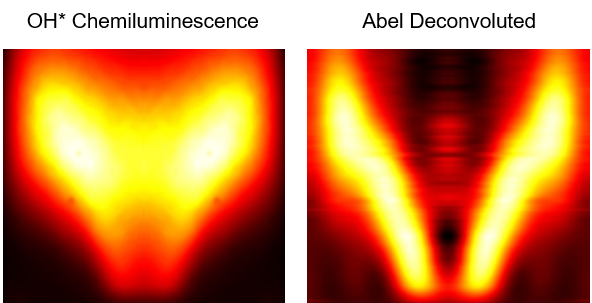Flame Chemiluminescence
Examples of swirling flame structure, averaged OH* Chemiluminescence and equivalent Abel Deconvoluted Image
Time-resolved chemiluminescence measurements are used to study the experimental flame. Measurements target electronically-excited intermediate chemical radicals depending on the composition of the fuel studied. Species measured include; OH*, NH2*, NH*, and CH*.
GTRC has the capacity to take these measurements at either high or low speed, depending on the experimental specification. For high-speed, we use a combination of Phantom v1212 high-speed CMOS camera, Specialised Imaging SIL40HG50 high-speed image intensifier, specialised lens, and narrow bandpass filters selected specifically for each radical species. For low-speed measurements, a Dantec HiSense Mk II, 1.3 megapixel CCD camera is coupled with a Hamamatsu C9546-C03L image intensifier, and similar lenses and filters.
Each instantaneous chemiluminescence image is typically filtered and temporally averaged from 2000 images. The averaged images are background corrected and processed using a modified Abel inversion algorithm to provide an axisymmetric planar representation of the electronically-excited radical species distribution. Quantification of the chemiluminescence signal can be further conducted using an integral intensity.
High-speed chemiluminescence measurements enable transient behaviour of the flame to be studied in detail, as can be seen with a thermoacoustic instability in the short video below - The full video with further details is available on the GTRC Videos page.
Thermoacoustic Instability Captured with High-Speed OH* Chemiluminescence
Back To Diagnostic Techniques
Copyright 2007-2020 Cardiff University - Gas Turbine Research Centre :: Privacy Policy :: Terms of Use

